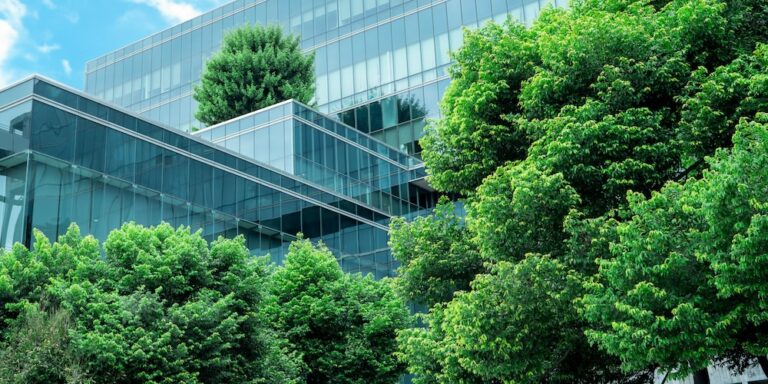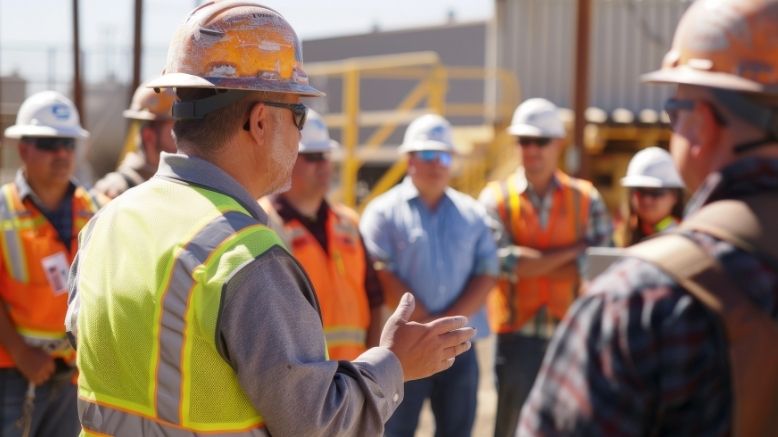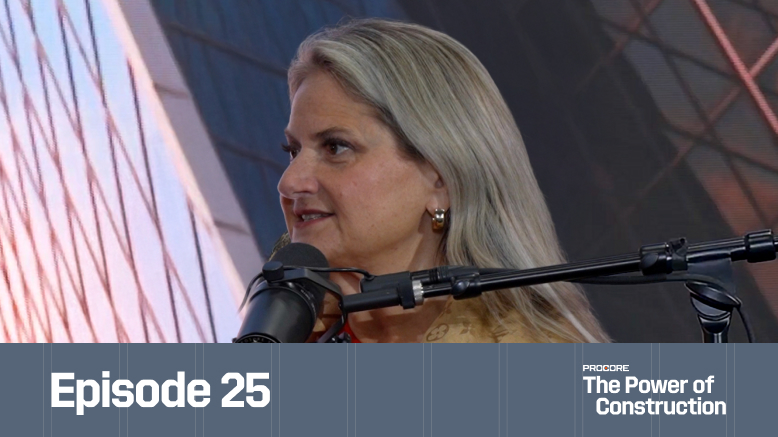— 10 min read
LEED Certification: The Process, Benefits & Feasibility


Last Updated Mar 21, 2025

Jeffrey Brooks
Solutions Engineer, General Contractors
Jeffrey Brooks has built a robust career in the construction and engineering industry, showcasing over a decade of hands-on experience as a Project Manager, Estimator and Project Engineer. Jeffrey holds a Bachelor of Science degree in Construction Management from Colorado State University, where he graduated in 2011. He is currently a Solutions Engineer at Procore Technologies, where he assists enterprise and major general contractors by leveraging innovative solutions.

Taylor Riso
Contributing Writer
91 articles
Taylor Riso is a marketing professional with more than 10 years of experience in the construction industry. Skilled in content development and marketing strategies, she leverages her diverse experience to help professionals in the built environment. She currently resides in Portland, Oregon.
Last Updated Mar 21, 2025

Energy efficiency and sustainability are becoming increasingly significant in the construction industry. LEED (Leadership in Energy and Environmental Design) certification offers a structured framework for recognizing and rewarding sustainable building practices. This can signify a commitment to environmental stewardship, enhancing the environmental performance of buildings and contributing to healthier living and working spaces.
However, pursuing LEED certification comes with its own set of challenges. Without clear and documented expectations of the certification process, projects can encounter obstacles that affect timelines and budgets.
This article examines the complexities of the LEED certification process, offering insights into its benefits, addressing common criticisms and providing practical strategies for successfully integrating LEED standards into construction projects to deliver both environmental and economic gains.
Table of contents
What is LEED Certification?
LEED, developed by the U.S. Green Building Council (USGBC), is a comprehensive rating system that certifies buildings based on their sustainability and environmental performance. This certification serves as an official recognition that a building meets established standards in areas such as energy efficiency, indoor air quality, material selection and water conservation.
Application
The criteria set by USGBC to achieve LEED certification should be meticulously integrated into the construction documents and specifications of a project, ensuring sustainable practices are embedded from the beginning of the design process through to the completion of construction. This systematic approach helps minimize the environmental impact of buildings while promoting healthier and more efficient living and working spaces.
Certification Levels
LEED certification has various levels, including Certified, Silver, Gold, and Platinum. Each level corresponds to a different set of points earned against a grading rubric, depending on the sustainability practices integrated into the project. Higher levels indicate more extensive sustainable practices, with each level requiring a certain number of points.
Distinguishing LEED Certification for Buildings and Accreditation for Individuals
It's important to differentiate between LEED certification for buildings and LEED accreditation for individuals. While buildings can earn LEED certification, individuals can achieve LEED accreditation through a structured process involving exams and professional experience.
The different levels of LEED accreditation for individuals include:
Green Associate
Entry-level accreditation
Accredited Professional (AP)
Specialized accreditation in areas such as Building Design and Construction, Operations and Maintenance, Interior Design and Construction, Neighborhood Development and Homes
LEED Fellow
The highest level of accreditation, requiring significant experience and peer review
This distinction between building certification and individual accreditation helps ensure that both physical structures and professionals are integral to enhancing sustainability in construction.
The LEED Certification Process
The LEED certification process involves a series of steps to establish that a construction project meets the defined sustainability standards.
1. Initial Steps
The first step in the LEED certification process is registering the project with the USGBC. This involves preparing construction drawings, design information and specifications that incorporate LEED criteria. Registration includes the submission of project documentation that outlines the sustainable practices and materials to be used. By ensuring that all design and construction plans align with LEED standards from the outset, projects set a solid foundation for achieving certification.
2. Implementation: Validating Credits
As construction progresses, the specified LEED credits are validated throughout the project. Contractors play a key role in ensuring that these practices are followed and documented meticulously. These responsibilities vary project by project, but generally speaking, this includes verifying that the products that are to be put in place match the requirements of the construction documents and specifications which have LEED requirements embedded into them. Contractors must submit detailed documentation at various stages of construction to validate the earned LEED credits. The final certification level is determined based on the total credits earned, which are assessed and confirmed by the USGBC upon project completion.
3. Certification Review
Upon completion of the project, a comprehensive review is conducted by the USGBC to assess the final documentation and verify that all LEED credits have been earned. This review process determines the final certification level based on the total points accumulated.
4. Post-Certification Maintenance
Maintaining LEED certification requires an ongoing commitment to sustainable practices. This includes regular maintenance of building systems, monitoring energy performance and assessing continued compliance with LEED standards. Post-certification audits may be conducted to verify ongoing adherence to sustainability criteria.
By maintaining stringent adherence to LEED criteria and thorough documentation, contractors help verify that projects meet the desired certification level, contributing to the overall sustainability and efficiency of the built environment.
Courses about construction.
For construction.
Unlock your career potential with our free educational courses on Health & Safety, Data in Construction, and more.
Why pursue LEED certification?
Pursuing LEED certification offers a comprehensive approach to advancing sustainable building practices, offering significant environmental, social and economic benefits.
Environmental and Social Responsibility
Pursuing LEED certification underscores a commitment to sustainability and reducing environmental impact. This certification addresses both environmental health and human health, leading to buildings that are not only more resilient to climate change impacts but also promote better living and working conditions. By enhancing indoor environmental quality, LEED-certified buildings may improve occupant health and productivity — helping demonstrate a company’s dedication to social responsibility.
Economic Benefits
LEED-certified buildings offer considerable economic advantages. They often result in energy and cost savings due to the implementation of more efficient building systems (HVAC, electrical, etc.). Additionally, LEED certification can boost a property's value and provide access to various financial incentives, such as tax credits, grants and subsidies. These financial benefits make LEED certification a sound investment for many projects. For example, economic incentives like Section 179D provide tax deductions for energy-efficient commercial buildings, further enhancing the financial viability of pursuing LEED certification.
Project-Specific Opportunities
LEED certification also opens up unique project opportunities, particularly in redeveloping previously hazardous sites. Projects that transform such sites can earn additional LEED credits, turning environmental challenges into opportunities for achieving higher certification levels.
Addressing site conditions such as brownfield redevelopment not only helps in earning extra LEED credits but also contributes to environmental cleanup and revitalization efforts. This strategic approach can enhance a project's sustainability credentials and improve its overall certification rating.
Contractor Responsibilities on LEED Projects
Contractors are central to the successful implementation of LEED standards in construction projects. Here are some specific responsibilities contractors may have when working on LEED projects.
Increased Documentation
Compared to other projects, contractors working on LEED-certified projects face extensive documentation and tracking. This includes submitting detailed records to establish that all materials and practices comply with LEED standards. Contractors must manage submittals for material compliance and validate LEED credits throughout the project. The thorough documentation process ensures every aspect of construction aligns with LEED criteria.
Compliance and Verification
Ensuring compliance with LEED standards involves scrutinizing submittals and verifying that products and materials meet the necessary criteria. This could be a verification of VOC criteria for paint, recycled content percentage for metal materials or a verification of locally sourced lumber.
In some cases, materials may be salvaged and reused on the project to meet LEED standards, further supporting sustainability goals. These practices help accumulate the necessary LEED credits and support the project's sustainability objectives.
Hiring External Consultants
For some projects, particularly high-profile ones aiming for higher certification levels, owners, contractors or architects may hire external LEED consultants. These consultants help manage the compliance process, ensuring all LEED requirements are met. Their expertise in overseeing documentation, compliance and verification enhances the likelihood of achieving the desired LEED certification.
By fulfilling these responsibilities, contractors play a key role in successfully implementing LEED standards, thereby contributing to the overall sustainability and efficiency of construction projects.
Challenges and Criticisms of LEED Certification
Despite its benefits, the LEED certification system faces several practical challenges and criticisms.
Financial and Resource Constraints
One of the most significant challenges in pursuing LEED certification is the added costs associated with sustainable materials, waste management and consultants. These expenses can be a deterrent for some projects. Sustainable materials and energy-efficient systems often come with a higher price tag and the additional documentation and tracking requirements further increase costs. Waste management practices, such as recycling and sorting, also add to the financial burden.
Long-Term Commitment
LEED certifications need to be renewed every two years, requiring buildings to maintain their standards over time. This can be challenging if maintenance is not properly managed or if the building’s use changes in ways that affect its sustainability criteria. Keeping up with necessary standards requires ongoing effort and resources, and any changes in the building’s operation or maintenance practices can jeopardize its certification.
Feasibility for Different Project Types
The feasibility of pursuing LEED certification varies significantly across different types of construction projects.
Public Buildings and Infrastructure
LEED certification is commonly pursued for public buildings like libraries and city halls. In many cases, LEED certification is required for public projects due to government mandates aimed at promoting sustainability and reducing environmental impact. These projects often use public funds, making it important to demonstrate fiscal responsibility and long-term cost savings. LEED-certified public buildings serve as examples of environmental stewardship and responsible construction practices, enhancing public recognition and property value. Achieving LEED certification aligns these projects with broader sustainability goals and demonstrates a commitment to the well-being of the community.
Challenges for Industrial Projects
Industrial and manufacturing projects may face constraints that make LEED certification less feasible. These projects often require specialized facilities and equipment that may not easily align with LEED standards. Tight construction timelines and high upfront costs for sustainable materials and energy-efficient systems can be significant barriers.
Additionally, the industrial processes involved may produce emissions or waste that complicate compliance with LEED criteria. The need for extensive documentation and waste management practices adds to the complexity and cost. As a result, industrial projects often struggle to justify the investment needed to achieve LEED certification given their unique operational and logistical demands.
Retrofit Projects
Existing buildings undergoing major retrofits can also pursue LEED certification. However, this involves complex decisions about whether to retain existing structures or build new ones, comparing the environmental impact of both options.
Retaining existing structures can reduce the environmental footprint associated with new construction but may limit the ability to incorporate the latest sustainable technologies. Conversely, new builds can offer greater flexibility in meeting LEED criteria but involve significant resource use and waste generation. Retrofit projects must carefully weigh these factors to determine the most sustainable and feasible approach to achieving LEED certification.
Stay updated on what’s happening in construction.
Subscribe to Blueprint, Procore’s free construction newsletter, to get content from industry experts delivered straight to your inbox.

LEED's Role in Driving Sustainable Practices
LEED certification is a key component in promoting sustainable practices and fostering resilient communities.
Holistic Approach to Sustainability
LEED is just one element of a broader sustainability strategy. To truly understand and mitigate a building's environmental impact, it is essential to conduct a full lifecycle analysis and engage in resilience planning. These processes evaluate the long-term environmental effects of a building from construction through to future demolition, and ensure that it can withstand and adapt to changing environmental conditions.
Additionally, ongoing maintenance and operations play a role in maintaining sustainability standards over the building's lifespan. By incorporating life cycle analysis, resilience planning and robust maintenance practices, projects can achieve a more comprehensive approach to sustainability.
Integration with Urban Planning
Integrating LEED standards with urban planning is essential for developing sustainable and resilient communities. LEED certification can support the creation of walkable communities, which reduce reliance on vehicles, lower emissions and promote healthier lifestyles. Mixed-use developments encourage people to live, work and shop in the same area, enhancing community cohesion and reducing transportation needs.
Thinking of communities as ecosystems emphasizes the importance of green spaces, efficient water management and local energy production. Green spaces not only improve air quality and support biodiversity but also provide recreational areas that enhance the well-being of residents. Effective water management systems, such as rainwater harvesting and sustainable drainage, help mitigate flooding and reduce water consumption. Local energy production, through solar panels or wind turbines, reduces the carbon footprint and enhances energy independence.
By aligning LEED certification with these urban planning principles, communities can become more sustainable and resilient. This approach ensures that urban areas are designed to adapt to future challenges.
Advancing Sustainable Construction
The pursuit of LEED certification in construction projects is a strategic decision that reflects a commitment to sustainability and environmental stewardship. While the benefits of LEED certification — such as enhanced sustainability, increased property value and long-term cost savings — are significant, the process involves navigating challenges like increased documentation, upfront costs and rigorous compliance requirements.
It is ultimately up to the project owner whether or not to pursue LEED certification. Their vision for sustainability sets the tone for integrating LEED standards into design and construction. This decision requires a careful balance between aspirational goals and practical considerations.
Was this article helpful?
Thank you for your submission.
100%
0%
You voted that this article was . Was this a mistake? If so, change your vote
Scroll less, learn more about construction.
Subscribe to The Blueprint, Procore’s construction newsletter, to get content from industry experts delivered straight to your inbox.
By clicking this button, you agree to our Privacy Notice and Terms of Service.
Thank you!
You’re signed up to receive The Blueprint newsletter from Procore. You can unsubscribe at any time.
Categories:
Written by

Jeffrey Brooks
Solutions Engineer, General Contractors | Procore
Jeffrey Brooks has built a robust career in the construction and engineering industry, showcasing over a decade of hands-on experience as a Project Manager, Estimator and Project Engineer. Jeffrey holds a Bachelor of Science degree in Construction Management from Colorado State University, where he graduated in 2011. He is currently a Solutions Engineer at Procore Technologies, where he assists enterprise and major general contractors by leveraging innovative solutions.
View profile
Taylor Riso
Contributing Writer
91 articles
Taylor Riso is a marketing professional with more than 10 years of experience in the construction industry. Skilled in content development and marketing strategies, she leverages her diverse experience to help professionals in the built environment. She currently resides in Portland, Oregon.
View profileExplore more helpful resources

Defending Against Financial & Legal Risks on Megaprojects
The construction industry has seen marked growth in megaprojects. Some experts classify any project over $500 million as a megaproject, while others argue that the build needs to be $1...

Unlocking Project Intelligence: Moving from Raw Data to Actionable Insights
The construction industry faces a wide range of challenges, from ongoing labor shortages to frequent cost overruns. But some the biggest hurdles all stem from unpredictability. The general contractors (GCs)...

Who is accountable for innovation in construction?
Everyone says construction needs to innovate—but no one agrees on who’s actually responsible for making it happen. Is it the owner? The builders? The tech vendor? Or is innovation everyone’s...

Integrated Project Delivery in Practice: A Framework for Collaboration
On construction projects, traditional delivery methods put different stakeholders in their own silos. While the design team feeds drawings and specifications to the general contractor (GC), the GC’s expertise in...
Free Tools
Calculators
Use our calculators to estimate the cost of construction materials for your next project.
Templates
Find a template to help you with your construction project tasks.
Material Price Tracker
Get the latest U.S. retail prices and view historical trends for common building materials.
Glossary
Explore key terms and phrases used in the industry.
